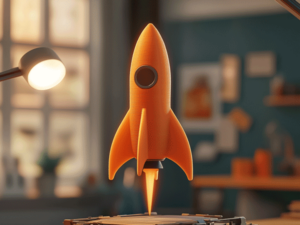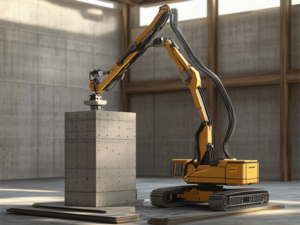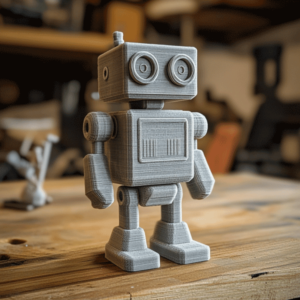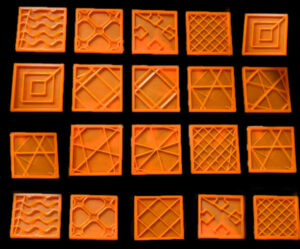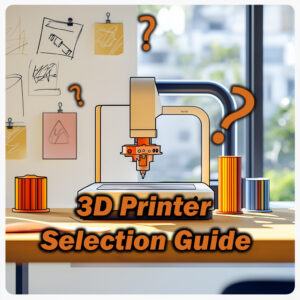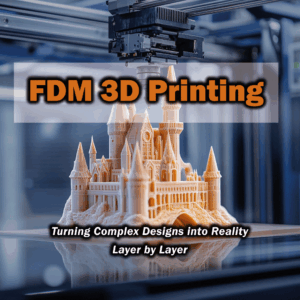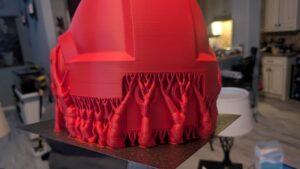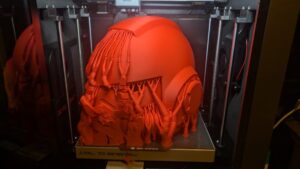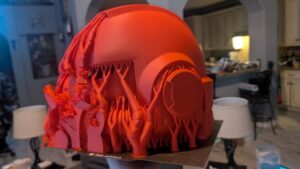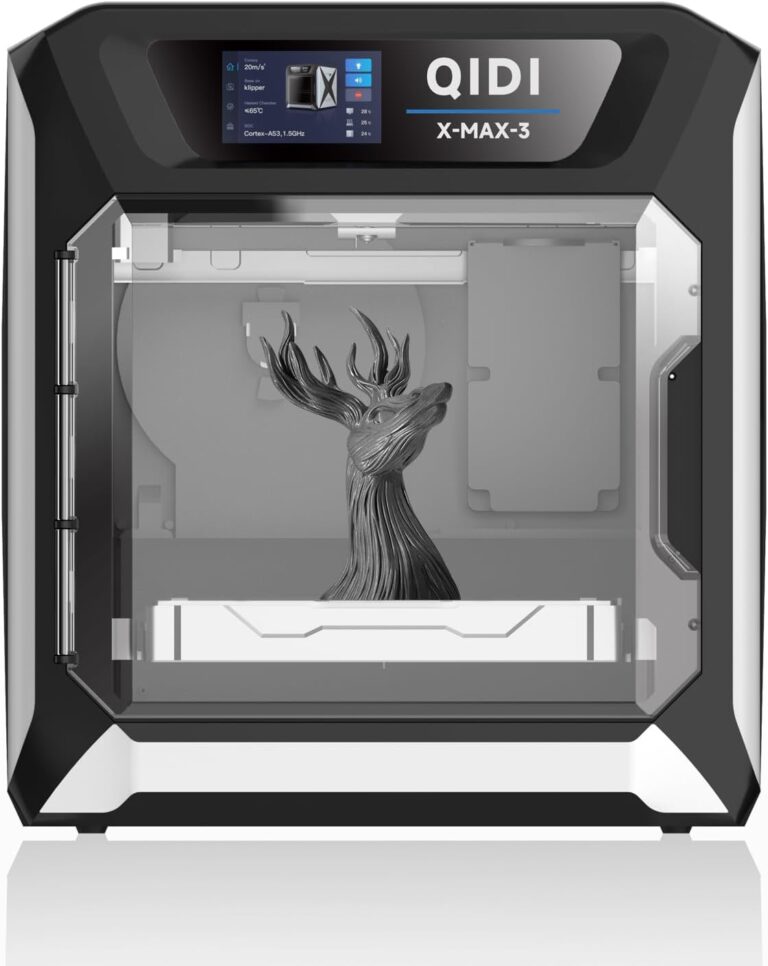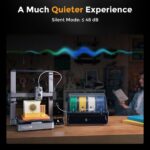QIDI PLUS4 3D Printer Review: High-Speed Printing with 600mm/s & 65°C Chamber
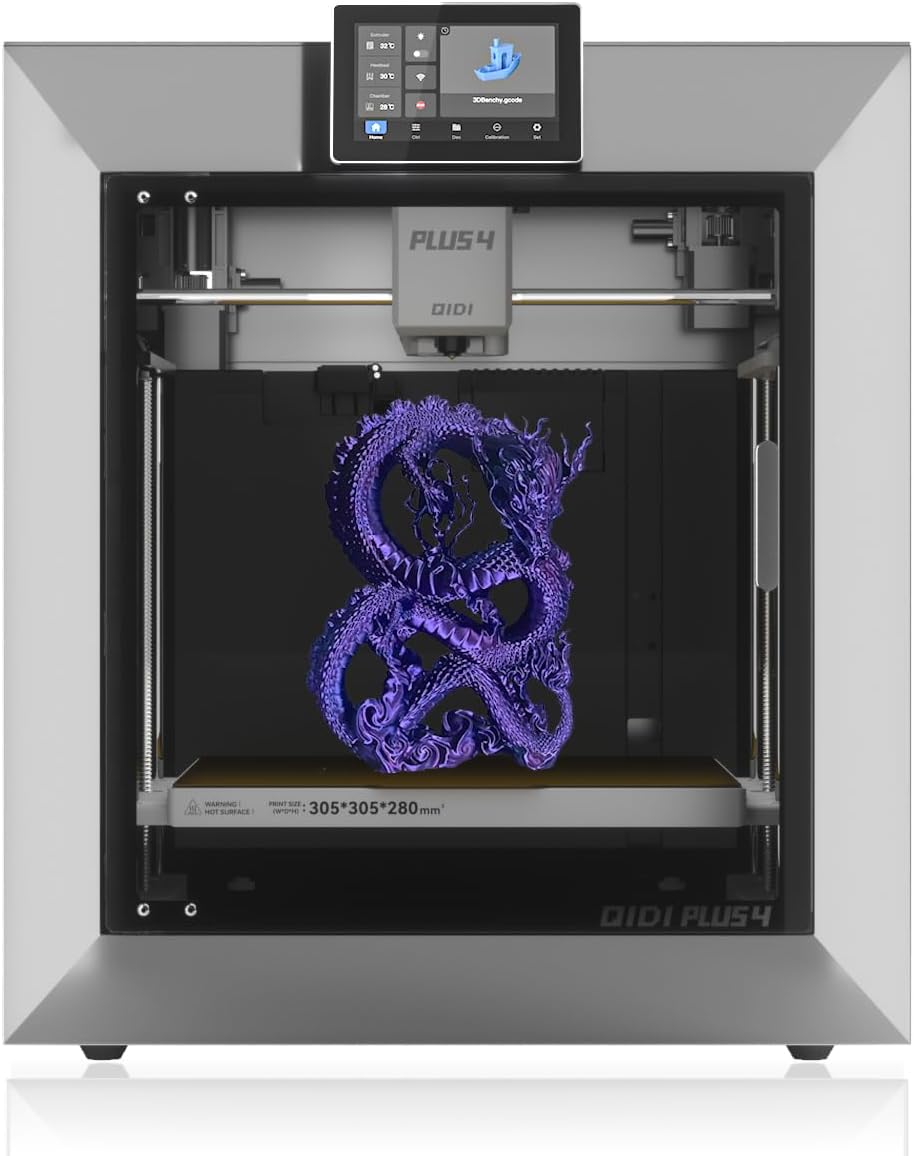
Interested in the QIDI PLUS4?
(As an Amazon Associate, I earn from qualifying purchases, at no extra cost to you. This helps support the blog.)
The QIDI PLUS4 is a material-extrusion (Fused Deposition Modeling, or FDM) 3D printer that marries blistering speed with a cavernous build volume. Built for both first-time makers and seasoned pros, it rockets up to 600 mm/s, flaunts a roomy print chamber, and packs a handful of smart extras. In this guide you’ll find the hard-core specs, real-world user feedback, a quick look at who each feature serves best, plus a no-nonsense pros-and-cons rundown. Drop it straight into a blog post or product listing—eye-catching, SEO-savvy, the whole nine yards. 🎉
⚙️ Technical Specifications & Performance
Wrapped in a fully enclosed metal shell and fronted by a bright touchscreen, the PLUS4 feels rock-solid straight out of the box. That spacious interior lets you bang out oversized prototypes—picture a full-size helmet—in a single shot.
📏 Build Volume: 305 × 305 × 280 mm (≈ 12 × 12 × 11 in). Plenty of elbow room to print big models in one piece—one user managed a life-size helmet without a single cut. Great for everything from cosplay props to engineering mock-ups.
⚡Print Speed & Motion System: Thanks to CoreXY kinematics the printer screams along at 600 mm/s with accelerations hitting 20,000 mm/s². Klipper’s input-shaping reins in vibration, while twin Z-motors riding beefy 10 mm linear rods and an auto belt tensioner keep the gantry square even at warp speed.
🔥Temperature Headroom: An 80-watt bimetal hotend climbs to 370 °C, unlocking high-temp filaments without breaking a sweat.
🔸Heated Bed: A 6 mm milled-aluminum plate reaches 120 °C and wears a spring-steel PEI sheet for effortless part release.
🌡️ Heated Chamber: A built-in 400-watt PTC heater brings the chamber up to 65 °C in about eight minutes, backed by dual-layer insulation and a circulation fan. The steady warmth nearly erases warping in ABS, ASA, and nylon.
🧶 Filament Compatibility: The direct-drive extruder grips 1.75 mm filament and ships with a 0.4 mm nozzle (0.2/0.6/0.8 mm optional). With that heat ceiling you can run PLA, ABS, PETG, TPU, ASA, PC, PA, carbon- or glass-fiber blends, and even peek-level exotics like PEEK or PPS-CF . Early users report smooth results with PLA+, ASA, and TPU and plan to push into PEEK and carbon-fiber territory next .
Pro tip: Warm the chamber when chasing ultra-hot filaments to boost layer bonding and dimensional stability.
🤖 Auto Calibration & Ease of Use: A full auto-level routine probes the bed, dials in the nozzle offset, and even wipes the nozzle pre-print—no hand-tuning needed.
📱 Touchscreen & Interface: Up top sits a 5-inch (800 × 480) color touchscreen. Under the hood it’s Klipper plus the Fluidd web UI, so you can tweak every setting from a phone or laptop browser (tomshardware.com). As Tom’s Hardware notes, this out-of-the-box Fluidd access lets tinkerers go wild while beginners just tap Print and walk away.
📷 Built-In Camera & Network Connectivity: A 1080 p camera sits inside the chamber and shoots smooth timelapse videos, letting you watch every layer build up from anywhere.
You can steer the printer and upload files over 2.4 GHz Wi-Fi or a hard-wired Ethernet port.
With the free QIDI mobile app, the live video feed and controls ride along in your pocket.
Heads-up: testers say the Wi-Fi radio is a tad weak—big files crawl over wireless, but an Ethernet cable wipes the issue clean.
🛡️ Filament Sensors & Safety: The PLUS4 is stacked with safeguards: a run-out sensor pauses prints when filament runs dry, a tangle detector spots knots before they wreck a job, and an integrated cutter lops off the old strand during swaps.
That auto-cutter is a crowd-pleaser—no more fumbling for side-cutters mid-print.
Power outage? No sweat—the printer remembers its last move and picks up right where it left off once the lights are back.
🏗️ Build Quality: Weighing in at about 30 kg, the all-metal frame soaks up vibration, keeping those high-speed moves razor-sharp.
Early adopters call it a “solid, well-built machine,” praising the zero-flex chassis.
An active-carbon filtration loop scrubs odors and stray particles from ABS and friends, making the printer apartment-friendly.
QIDI PLUS4 packs an impressive punch in its class when it comes to hardware and raw performance. Below you’ll find a quick side-by-side tech rundown against two other fan-favorites in the same high-speed 3D-printer bracket:
| Feature 🛠️ | QIDI PLUS4 | Bambu Lab P1S | Creality K1 |
|---|---|---|---|
| 3d Printing Tech | FDM (CoreXY) | FDM (CoreXY) | FDM (CoreXY) |
| Max Speed 🚀 | 600 mm/s | 500 mm/s (default) | 600 mm/s |
| Acceleration ⚡ | 20 000 mm/s² | 20 000 mm/s² (default) | 20 000 mm/s² |
| Build Volume 📦 | 305 × 305 × 280 mm | 256 × 256 × 256 mm | 220 × 220 × 250 mm |
| Nozzle Max Temp 🔥 | 370 °C | ~300 °C | ~300 °C |
| Bed Max Temp ♨️ | 120 °C | 120 °C (est.) | 100 °C (est.) |
| Heated Chamber 🌡️ | Active 65 °C | Passive (door closed) | None (fan only) |
| Multi-Color 🎨 | External QIDI Box (opt.) | AMS module (opt.) | Not yet |
| Camera 📷 | Yes, 1080 p | Yes (720 p) | — |
| Filament Sensors 🧵 | Run-out + Tangle, cutter | Run-out (with AMS) | Run-out |
| Software / FW 💾 | Klipper (Fluidd UI) | Bambu X1 FW (Klipper-based) | Custom Klipper fork |
Table 1 — A snapshot of QIDI PLUS4 versus other speedy contenders. The Plus4 really shines thanks to its roomy build volume, high-temperature extrusion, and fully active heated chamber.
👍QIDI PLUS4 Advantages
⚡ High Print Speed & Efficiency: At up to 600 mm/s, the PLUS4 chews through long-haul print jobs, handing you back hours you’d otherwise spend watching a status bar crawl. Makers swapping from older rigs rave about how quickly this machine spits out finished parts. Better yet, smart input-shaping reins in noise and wobble even at full tilt, so you get rapid prototypes or short-run production pieces without sacrificing quality.
📦 Large Build Volume: Boasting a roomy 30 × 30 × 28 cm workspace, the PLUS4 makes many rivals look downright cramped. Want a full-size cosplay helmet or an oversized architectural model in one go? No problem. And if you run a small shop, that extra real estate means you can batch-print a tray of smaller widgets all at once—streamlining production and cutting turnaround times.
🔄 Broad Material Compatibility: A 370 °C hot end teamed with a 65 °C heated chamber turns the PLUS4 into a materials chameleon. Everyday filaments—ABS, ASA, PETG, TPU—flow like butter, while tougher stuff such as nylon, polycarbonate and carbon-fiber blends print cleanly once you dial in a profile. The enclosed, temperature-stable shell tames warping on notoriously finicky resins, something engineers and seasoned tinkerers absolutely love.
🎛️ Automatic Calibration & Quick Setup: The printer shows up practically built; snap on the touchscreen and spool holder, follow a four-step quick-start, and you’re melting plastic in under ten minutes. Guided calibration on the display levels the bed for you, trimming human error. One user even bragged about launching their very first print fifteen minutes after unboxing—a true plug-and-play dream for newcomers.
🎯 Print Quality & Consistency: Owners report steady, high-grade output—crisp layer lines, silky surfaces, zero layer shifts. A maker who tweaked an initial hiccup then churned out eleven flawless parts in a row. Reviewers echo the praise, calling the PLUS4 a “quality-print” workhorse that shrugs off vibration artifacts even on broad, smooth walls.
💻 Software & Open-Source Friendliness: Built on Klipper, the PLUS4 lands with tuned profiles that blend race-car speed with showroom detail. Tinkerers can pop the hood via the Fluidd interface, while everyone else can slice parts in QIDI Studio or community favorites like PrusaSlicer and OrcaSlicer. One longtime user simply called the bundled slicer “stellar”—and we’re inclined to agree.
🤝 Customer Support: QIDI’s support crew has earned a loyal fan base. Folks recount reps jumping on minor hiccups, shipping replacement parts free of charge, and generally treating questions like VIP tickets. If you’re planning to keep a printer busy for years, knowing real humans have your back is worth its weight in filament.
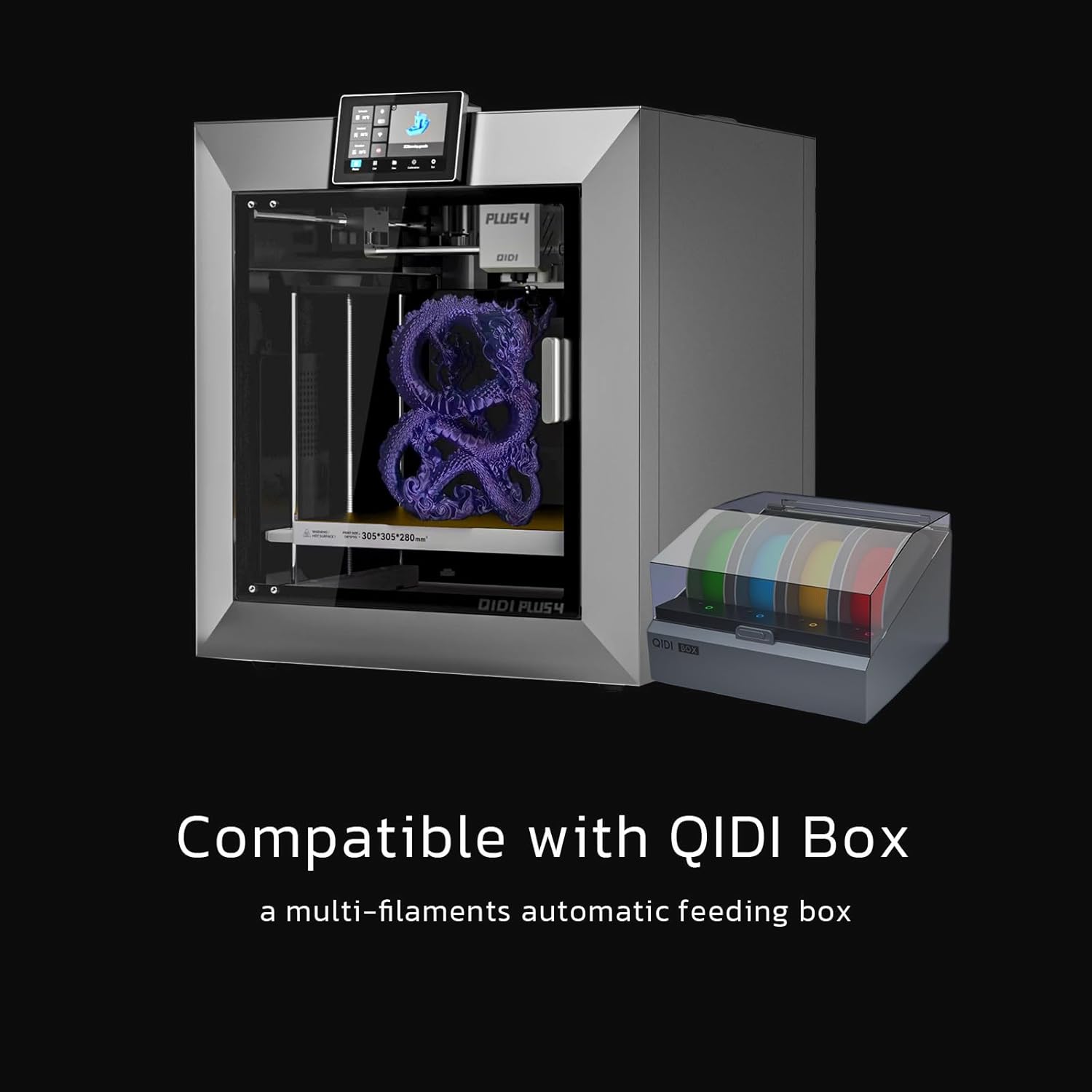
Check Price & Learn More on Amazon
(As an Amazon Associate, I earn from qualifying purchases, at no extra cost to you. This helps support the blog.)
Disadvantages of QIDI PLUS4
💸 Price Balance: At around $800, the PLUS4’s sticker price can feel punchy to casual makers. Still, as GamingTrend puts it, it’s “shockingly well-priced” once you stack up the specs against the competition.
🔄 Firmware Updates: A few owners bump into hiccups during first-time setup—one Reddit user, for instance, couldn’t flash over Wi-Fi and had to fall back on a USB stick. Annoying? Sure. Deal-breaker? Not really, once the latest firmware’s onboard.
📚 Learning Curve: Right out of the box, printing is a breeze; yet to squeeze every last drop of performance you’ll want to dive into Klipper tweaks and advanced profiles. Factory settings are fine—until curiosity kicks in.
🎨 Single-Color Limitation: The PLUS4 ships with a lone extruder, meaning multi-color dreams stay on hold until QIDI’s upcoming “QIDI Box” drops. Tom’s Hardware notes this nudges the machine toward small-business workloads more than living-room art projects.
📏 Size & Weight: Tipping the scales at 30 kg and measuring roughly 50 × 50 × 55 cm, the unit is anything but pint-sized. Plan on giving it a permanent parking spot—your back will thank you later.
🔊 Operating Noise: That zippy CoreXY chassis and high-RPM cooling fans kick up a noticeable hum. The fully-enclosed frame mutes the racket, but don’t expect library-level silence.
🖥️ Interface Lag: Some testers report the touchscreen hesitating and large files crawling over Wi-Fi. A quick fix? Pop in an Ethernet cable or a trusty flash drive and watch transfers fly.
👥 User Reviews & Experiences
Since the day the QIDI PLUS4 hit the shelves, it’s been the talk of both Amazon product pages and hobby hang-outs like Reddit’s 3D-printing threads. The consensus? By and large, the printer delivers on the swagger its spec sheet promises—though a handful of folks have bumped into hiccups here and there. Below you’ll find a deep-dive into user feedback pulled from several corners of the web, sifted and stitched together for clarity.
✅Overall Satisfaction
On Amazon, PLUS4 is cruising along with an impressive 4.3 / 5-star average—a score high enough to make rival machines blush.
Shoppers rave about print quality, speed, and the machine’s sturdy build. One buyer puts it bluntly: “It’s a solid, well-built machine that gets things done quickly and makes them look good while doing it.”
Another proudly reports pulling off a hefty model with “flawless print quality for this large-ish print.”
👍Ease of Use
Plenty of owners highlight just how user-friendly the printer feels. Several Amazon comments mention being “print-ready in about 15 minutes right out of the box.”
The touchscreen interface gets kudos for clarity, while QIDI Slicer is praised as “straight-up intuitive.” Seasoned makers even admit the PLUS4 serves up “the smoothest auto-printing experience I’ve seen so far.”
A few nitpicks exist—some users catch the menu lagging or the touchscreen missing a tap now and then—but the broader take is plug-and-play simplicity with room to tweak for power users.
⚡Print Speed & Quality
Redditors confirm the PLUS4 really does reach its advertised high-speed numbers without butchering surface finish. One frustrated Creality owner jokes, “I’m done with the K1 trash—this thing actually looks promising.”
Another maker—tired of endless tune-ups on a previous printer—celebrates finally owning a machine that “just runs, no babysitting required.” That said, a few veterans warn that hammering out marathon projects at full tilt could accelerate mechanical wear, so they nudge the speed slider down a bit for epic prints.
Even so, the majority stay impressed with how well the PLUS4 holds detail, even when the needles are pinned.
🧱 Large Prints & Long-Haul Jobs
Thanks to its roomy build volume, PLUS4 has been thrown into days-long print marathons—and the feedback is eye-catching. A GamingTrend editor logged 150 + hours on a giant Space Marine suit and, apart from the very first test piece, “I didn’t have a single failed print.”
That kind of rock-solid reliability is gold for small shops and pros alike. Not every story is sunshine, though: one Redditor said the machine “worked great for six days, then crapped the bed,” only to have QIDI swoop in with a quick parts swap that got it humming again.
🛠️ Technical Support & Firmware TLC
On Amazon, users shower QIDI’s customer-service crew—Andy and Lisa pop up a lot—with praise, pointing to free replacement parts that fixed minor quality hiccups.
Reddit tells a more tangled tale: one owner wrestled with a fan failure and flaky sensors, claiming the email back-and-forth dragged on and ended in a refund request.
Even so, the broader vibe is positive, especially as QIDI keeps rolling out firmware tweaks based on community chatter (that early touchscreen lag? already patched).
⚖️ Side-by-Side Takes
Seasoned makers can’t resist stacking PLUS4 against rivals—especially Bambu Lab’s X1/P1 line. The informal verdict: QIDI wins on build heft and a heated chamber, sitting somewhere between Creality’s budget feel and Bambu’s polish. One Arrma forum post says the printer “lands squarely between Creality and Bambu; price aside, it nearly matches Bambu’s automation while adding that toasty chamber.”
Tom’s Hardware echoes that vibe, noting “When the X1 Carbon runs out of space, the QIDI PLUS4 steps in.”
Hobbyists who live for multicolor art still lean toward a Bambu P1 S + AMS combo, simply because PLUS4 doesn’t (yet) juggle filaments on the fly.
📝 Bottom Line
Overall, the crowd is upbeat: PLUS4’s promised speed-plus-quality punch shows up in real-world prints, and even the few glitches reported were mostly solved. For anyone upgrading from an older QIDI or a rival brand, the jump feels unmistakably forward.
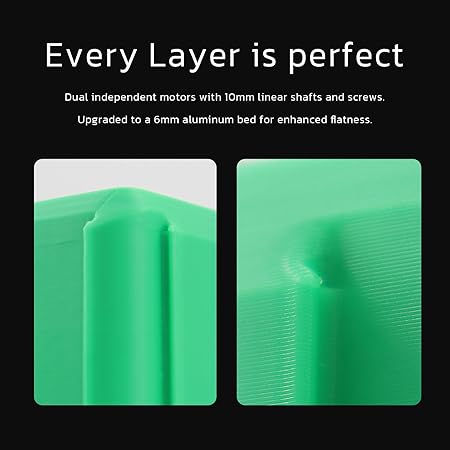
QIDI PLUS4?
If you’re considering purchasing the QIDI PLUS4 3D Printer, you can check its current price and availability on Amazon through the link below.
Affiliate Disclosure: Please note that the link below is an affiliate link. This means if you click on the link and make a purchase, I may earn a small commission at no extra cost to you. This commission helps support the blog and allows me to continue creating detailed reviews and helpful content like this. Your support is genuinely appreciated!
Check Price & Learn More on Amazon
(QIDI PLUS4 3D Printer)
References
QIDI Tech. (n.d.). QIDI PLUS4 3D Printer Product Page.
GamingTrend. (n.d.). QIDI PLUS4 3D Printer Review: Incredibly Easy, Fantastic Results.
Tom’s Hardware. (n.d.). QIDI PLUS4 Review.
Geekbuying. (n.d.). QIDI PLUS4 Product Overview.
Fakespot. (n.d.). QIDI PLUS4 3D Printer Review Authenticity Check.

